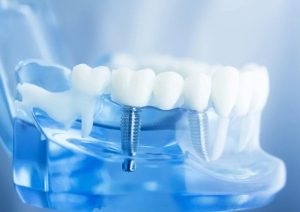
What is a Dental Implant?
A dental implant, most simply stated, is a prosthetic root replacement. Let me better explain; a natural tooth is composed of two key components–the crown and the root. The crown is the visible part of the tooth above the gums and jaw bone. The root is the non-visible portion of the tooth below the gums and is physically connected to the jaw bone. A dental implant is a titanium screw that is inserted deep into the jaw bone below the gum tissues and is not visible when looking in one’s mouth. It serves as a prosthetic tooth root. This prosthetic root can be restored with a variety of prosthetic tooth options. This is important to understand as one starts down the road of dental implant treatment because when one pays for a dental implant, they are paying for the process of getting the root with no prosthetic tooth included in that fee.
Are Dental Implants Safe?
The dental implant treatment is very safe when properly planned and executed. The human body has shown to have a very favorable response to titanium. It is considered to be biologically inert and should not elicit an immune response. Most dental scientific research supports the concept that the human body likes titanium in a way that it will grow bone directly and intimately onto the surface of the titanium. Scientific research suggests and supports that there is very little evidence of people having or developing a titanium allergic reaction. However, there are some that who suggest that as the human population is exposed to increasing amounts of titanium (via products and medical/dental treatments), we might expect to see an increase in titanium allergic reactions in the future. Thus, for the majority of people in the world, titanium dental implants will be a safe potential solution.
What is the Success Rate of Dental Implants?
Scientific dental research suggests that the success rate of dental implants should be in the range of 93 to 99%. It is important to note that these statistical numbers are derived from research completed in more controlled environments with healthy patients and performed by highly trained dental professionals (usually dental specialists). This means that even in the best situations and with the most highly trained professionals, 3 to 7 implants out of 100 will not succeed. Scientific research shows that in these scenarios one can still obtain dental implant success in the areas of failure if the proper steps are taken to perform the procedure a second time. These statistics are also numbers describing initial success following the dental implant surgery. Research evaluating the more long-term success of dental implants suggest a success rate of 85 to 95%. This suggests implants can fail later on in life.
What factors are involved with dental implant success?
There are two main categories that help improve dental implant success. These categories are:
1. The person receiving the dental implant.
There are not too many situations or conditions that exclude one from being able to successfully undergo dental implant treatment. Some conditions that may play a role in implant success include: history of head and mouth radiation as part of cancer treatment, systemic diseases that reduce one’s ability to heal properly (AIDS, uncontrolled diabetes, certain autoimmune diseases), certain medications one takes to treat underlying diseases or conditions (i.e. IV Bisphosphonate), and smoking. The other major factor related to the person receiving the dental implant treatment is the jaw bone quality and quantity. Dental implants must have sufficient bone immediately adjacent to the dental implant to attain and maintain success.
2. The training and expertise of the people performing the dental implant procedures.
The training, expertise, and execution of the dental implant treatment are the most important factors involved with success. We know what factors need to be present for dental implant treatment to work. Many of the complications associated with dental implant treatment are related to improper diagnosis and treatment execution. Obviously, the person’s biology plays a huge part in success, but it is imperative that the proper diagnosis, treatment plan, and execution of that treatment plan is pursued to maximize the potential of dental implant success in one’s mouth.
What types of dental prosthetics can be attached to dental implants?
There are a variety of options with respect to dental prostheses that can be attached to a dental implant to help replace missing teeth. These options can range from one single tooth replacement prosthesis to a prosthesis that replaces all of one’s teeth. The options might be: the replacement of a single tooth with a crown, the replacement of 2 or more teeth with a bridge, the replacement of several missing teeth with a snap-in removable prosthesis or partial denture, the replacement of all of one’s teeth with a snap in removable prosthesis or denture, and the replacement of all of one’s teeth with a fixed non-removable prosthesis or full mouth implant bridge.
All these options provide a different level of comfort and function for the teeth being replaced. In general, fixed or non-removable options provide a greater functional ability and ultimately provide more comfort when compared to the removable options. When fixed options are used the teeth being replaced are being replaced with the most advanced technology and techniques dentistry has available. However, if a fixed option is not the one that fits the expectations of a patient and a removable option does then the use of dental implant to help support and retain the removable teeth improves the overall outcome tremendously when compared to just removable prostheses without the use of dental implants.
What is the process of a dental implant used to replace one tooth?
The first step in the process to replace a single tooth with a dental implant is losing the tooth. Usually, a bad or non-restorable tooth is removed surgically from one’s jaw bone. Once a tooth is removed from the jaw bone the jaw bone has to heal or fill in the bony defect left as a direct result of removing the tooth. The process usually requires 10 to 12 weeks to heal. Knowing that implant success is influenced by the amount of healthy bone immediately surrounding the dental implant it is common practice to place bone grafting material immediately into the tooth extraction site once the tooth is removed. The bone graft helps ensure the jaw bone thickness remains as thick as possible during healing. If bone grafting is used the healing time will most likely require 3 to 4 months. Once the bone has healed it needs to be evaluated using a cone beam ct scan. This radiographic image allows the dentist to first evaluate the bone quality and quantity. If the bone quality and quantity is adequate, they are then able to virtually plan and perform the exact and precise implant placement in the bone using a computer program to best support a crown. Once it is planned correctly, an implant surgical guide is designed and printed that will be used during the actual surgery to ensure the implant is inserted into the correct position in the jaw bone. After the guide is fabricated the surgery can be accomplished. The surgery is usually accomplished and should be accomplished by a highly trained dental surgeon. The best recommendation for success is the dental implant is inserted into one’s jaw bone and a healing abutment is inserted to the top of the implant allowing the gum tissue to heal around the abutment. Healing from an implant insertion surgery requires 6 to 10 weeks. The healing time allows one’s body to actually grow bone onto the surface of the implant. There are a couple tests that a dentist can and should perform to verify the implant has successfully healed within one’s jaw. These tests are called a reverse torque test (a dentist will apply force to reverse the implant out of the bone and record the value) and an Osstell reading (an Osstell reading is a measurement of the stability of the implant within the bone using resonance frequency). If the implant proves to be integrated the fabrication process of a single crown can start. The process of crown fabrication requires a minimum of 2 visits. During the first visit the dentist will make and impression of the teeth and implant, make notes regarding the needs of that tooth shape and color, and make some essential records align the teeth and send that data to the lab to fabricate the crown. The lab usually takes 2 to 4 weeks to fabricate the crown. At the next appointment the new crowns will be tried run and inserted if it fits correctly and is approved by the patient.
What is the process to get a snap in denture?
In order to be treated with dental implants to support a snap-in denture the very first step is losing or having one’s teeth. In the case of a denture, one will need to have all their teeth removed. Once the teeth have been removed or lost and it has been determined an implant snap-in denture is the correct treatment it is critical to properly identify the best locations for the dental implants to retain the dentures. The implant location should first be determined by identifying the location of the teeth. Once the proper tooth location is determined the implants location can be selected. The implant location should provide the maximum retention, support, and restorative space for the snap-in teeth. If any of these are not correct the implant success is decreased as is the success of snap-in teeth. Thus, the basic process is to identify the proper position of the new teeth both esthetically and functionally. Then identify the proper location of the dental implants so best support and retain the new teeth. Using that data from the planning an implant surgical guide should be fabricated that will guide the implant insertion into the jaw bone to be more precise. The implants must then heal for 8 to 12 weeks to allow for the bone to properly grow onto the implant surface. Once the healing is complete the final snap-in teeth can be fabricated accurately. During the implant surgery and following the implant surgery one can wear a healing set of dentures or their existing set of dentures if reasonably acceptable.
